Abstract
Weeds in paddy fields can seriously reduce rice yield. An intra-row weeding device with double-layer elastic rods was designed, considering the differences in mechanical properties between rice and weeds, which can press weeds into the soil and avoid damaging rice. The elastic force of the elastic rods can be adjusted by changing the position of the regulating mechanism to adapt to different weeding conditions. A measurement experiment was conducted to determine the variation rule of elastic force. The quadratic orthogonal rotation combination discrete element simulation experiment, which used weeding depth and weeding speed as experimental factors, and the amount of soil disturbance and the force of the inner and outer elastic rod in the horizontal and vertical directions as experimental indicators, was conducted to study the interaction between the weeding device and the soil. The optimal weeding parameters were obtained: the weeding depth was 15 mm, the weeding speed was 0.9 m/s. The field experiment, which used the various parameters of the weeding device as experimental factors and the weeding rate and damaging seedling rate as experimental indicators, was conducted to determine the weeding effect. The experimental results showed that the optimal position of the regulating mechanism was 270 mm, with a weeding rate of 80.65% and a damaging seedling rate of 3.36%. The weeding rate can be increased by at least 11.18% by adjusting the regulating mechanism to a suitable position under the same weeding conditions. This study can provide a reference for research on weeding machinery for organic rice.
1. Introduction
Weeds in paddy fields compete with rice for sunlight, air, nutrients, and growing space [1,2,3,4], and are the spreaders of rice diseases and pests. Weeds directly or indirectly affect the growth, yield, and quality of rice. Therefore, weed control is of great importance for growing rice. Chemical weeding is currently the most commonly used method around the world [5,6,7,8,9], but pesticide residues can cause serious environmental pollution and damage to human health [10,11,12,13,14]. In order to effectively control the use of pesticides and ensure the safety of food production, the Ministry of Agriculture in China has implemented the “Double reduction” measures of chemical pesticides and fertilisers, especially in reducing the use of pesticides. And the planting area of organic rice will increase year by year with the improvement of people’s living standards. Therefore, how to reduce the use of chemical herbicides is extremely urgent. Non-chemical weeding, which includes artificial weeding, mechanical weeding, physical weeding, and biological weeding [15,16], is used for the weeding of organic rice [17,18,19]. Artificial weeding has high labor intensity and production cost; biological weeding mainly involves releasing ducks, loaches, crabs, and fish in paddy fields, but it can only control some weeds and is highly affected by the environment. Physical weeding, such as paper film mulching, has a high cost and less application. Mechanical weeding can maintain the stability and permeability of soil structure, accelerate the decomposition of soil nutrients, and improve soil fertility [20,21,22]. Thus, mechanical weeding will become a major weeding method in non-chemical weeding [23,24,25] and is in line with the trend of sustainable, high-quality, efficient, and agricultural green.
Mechanical weeding, including inter-row and intra-row weeding, generally uses the method of burying weeds in the soil to isolate them from sunlight and air [26]. Intra-row weeds that are closer to rice plants are difficult to remove and mechanical weeding is more likely to cause damage to rice during weeding. Japan has relatively mature research on intra-row weeding machines, including rotating tine discs, rotating umbrella discs, swinging comb teeth, fixing weeding wire, and so on [19], this does not apply to China, which needs to independently develop intra-row weeding technology in paddy fields. The weeding machinery in paddy fields in China is still a short board, although some intra-row weeding devices, including rotating tine discs, rotating umbrella discs, intra-row tine discs, swinging cutter teeth, and so on, have been developed by some researchers [24,25,26] which are at the experimental research stage and have not yet been put into rice production. There are some problems such as low weeding rates and high damaging seedling rates with these weeding devices. Therefore, it is urgent to independently develop a mechanical intra-row weeding device for organic rice to achieve efficient and green ecological weeding.
In this paper, according to the plant and root differences between rice and weeds, an intra-row weeding device with double-layer elastic rods, with which the elastic force can be adjusted, was designed based on the selective principle of mechanical weeding. The mechanical relationship between the weeding device and rice, weed, and soil was analysed to clarify the weeding mechanism. A measurement experiment of the elastic rod for elastic force was conducted to determine the variation law of elastic force. A discrete element simulation experiment was conducted to analyse the interaction between the weeding device and the soil to determine the optimal weeding parameters. The field experiment was carried out to verify the weeding effect. The intra-row weeding device can be used for weeding under different weeding conditions.
2. Materials and Methods
2.1. Design of Intra-Row Weeding Device
2.1.1. Mechanical Properties of Rice and Weeds
Rice and weeds had different mechanical properties due to different plant height, stem diameter, and growth characteristics. The weeding periods of rice were 7 days and 15 days after transplanting. In this study, the mechanical property parameters of rice and weeds were obtained from the relevant literature [27] and measuring experiments using a bending force meter and a tensiometer. The results are shown in Table 1. It can be concluded that rice was stronger than weeds, and the minimum bending resistance and pullout forces of rice were greater than those of weeds. Therefore, the intra-row weeding device can be designed according to the differences in mechanical properties between rice and weeds.

Table 1.
Mechanical properties of rice and weeds.
2.1.2. Structure and Working Principle of Intra-Row Weeding Device
The intra-row weeding device for organic rice included four sets of weeding components that were composed of double-layer elastic rods, an elastic regulating mechanism, a connecting frame, an installing frame, and a fixing plate, as shown in Figure 1. The double-layer elastic rods were made of elastic steel wires and composed of inner and outer elastic rods of which the front ends were fixed in a fixing plate and the ends were intersected with each other. The fixing plate was installed on the installing frame which was connected to the frame through a connecting frame. The elastic regulating mechanism was composed of guide rails that were installed on the fixing plate and sliding blocks that were installed on the guide rails. The elastic rods passed through the interior of the sliding blocks that can slide along the guide rails. When the elastic rods experienced different displacements in the horizontal or vertical directions, it could generate different elastic forces at the ends. Therefore, the force at the ends can be changed by controlling the displacements of the elastic rods, which can be limited by adjusting the positions of sliding blocks on the guide rails.
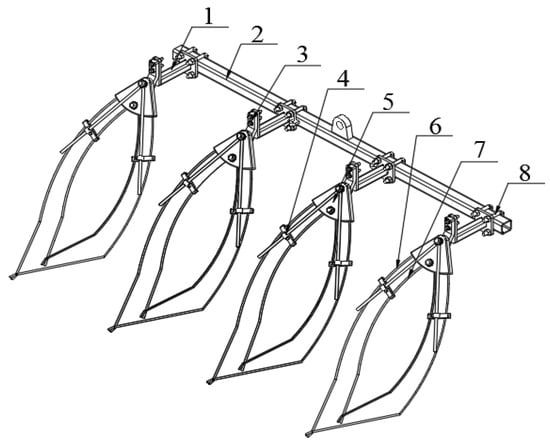
Figure 1.
Schematic diagram of the intra-row weeding device: (1) connecting frame; (2) frame; (3) installing frame; (4) elastic regulating mechanism; (5) fixing plate; (6) outer elastic rods; (7) inner elastic rods; (8) U-bolt.
The intra-row weeding device performed weeding at a certain depth into the soil under the traction of the walking platform. The elastic rods pressed the weeds into the soil or pulled weeds out of the soil when the weeding device passed through weeds because the forces of the elastic rods at the ends were greater than the bending resistance and pullout forces of weeds. The inner and outer elastic rods can press weeds twice. At the same time, the weeding depth and weeding range of the outer elastic rod were greater than those of the inner, so as to improve the weeding effect. The ends of the elastic rods were opened when the weeding device passed through rice, because the forces of the elastic rods at the ends were less than the minimum bending resistance, and the pullout and damaging plant forces of rice. The regulating mechanism can adjust the forces of the elastic rods at the ends. When the stems of rice are weak, the forces of the elastic rods at the ends should be reduced by moving the sliding blocks far away from the ends of the elastic rods to prevent damaging rice. When the stems of weeds are strong or the soil moisture content was high at a certain range, the forces of the elastic rods at the ends should be increased by moving the sliding blocks closer to the ends of the elastic rods to ensure that weeds can be pressed into the soil. The design of the regulating mechanism allowed the weeding device to be adapted to different weeding conditions.
2.1.3. Mechanical Analysis of Weeding Process
The weeding device interacted with soil, weeds, and rice during weeding. Figure 2 showed the acting force of the weeding device on weeds or rice in the vertical direction. The direction of acting force F′ was horizontal or obliquely upward or downward. When the direction of the acting force was horizontal (Figure 2a) and F′ > Ff—that is, the force of the weeding device was larger than that of rice or weeds—the weeding device could overwhelm rice or weeds. When the direction of the acting force was obliquely upward (Figure 2b), F1′ > Ff and F2′ > Fb, rice or weeds could be pulled out of the soil. When the direction of the acting force was obliquely downward (Figure 2c), F1′ > Ff and F2′ > 0, rice or weeds could be more easily pressed into the soil. In addition, because of the different bending resistances of rice stems and leaves at different positions, the higher the action point O was, the easier weeds or rice were to bend, but it was difficult to press weeds into the soil. In conclusion, according to the above analysis and mechanical properties of rice and weeds, it was easier to achieve the weeding requirements to press weeds into the soil. Therefore, the action point of the weeding device to weeds should be close to the roots. The direction of the acting force should be horizontal or obliquely downward. And the acting force of the weeding device should be larger than the bending resistance force of weeds, but less than that of rice.
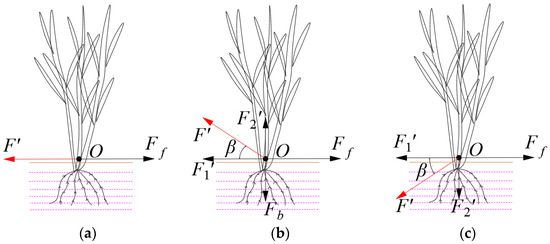
Figure 2.
Mechanical analysis of the weeding device to weeds or rice in vertical direction: (a) horizontal; (b) obliquely upward; (c) obliquely upward. O is the action point of the weeding device to weeds or rice. F′ is the force of the elastic rods to weeds or rice, N; F1′ and F2′ are the component forces of F′ in horizontal and vertical directions, N; β is the angle between F and the horizontal plane, deg; Ff is the force of the soil resistance, N; Fb is the maximum static resistance force of rice roots, N.
The force schematic diagram of the weeding device on weeds and rice in horizontal direction is shown in Figure 3. When weeds only touched the elastic rod on one side, the acting forces included F, Fc, and Ff. If weeds can be pressed into the soil, the forces of the weeding device on weed should meet the following requirements:
F > Fc + Ff
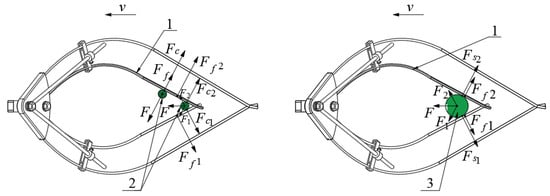
Figure 3.
Mechanical analysis of the weeding device acting on weeds and rice in a horizontal direction: (1) intra-row weeding device; (2) weeds; (3) rice; F1, F2 are the forces of the elastic rods acting on weeds or rice, N; F is the resultant force of F1 and F2, N; Fc, Fc1, and Fc2 are the forces of weeds acting on the elastic rods, N; Fs1 and Fs2 are the forces of rice acting on the elastic rods, N; Ff, Ff1 and Ff2 are the forces of the soil resistance, N.
When weeds simultaneously touched the elastic rods on both sides, the acting forces included F, F1, F2, Fc1, Fc2, Ff1, and Ff2. If weeds can be pressed into the soil or pulled out, the forces of the weeding device on weed should meet the following requirements:
F1 > Fc2 + Ff2
F2 > Fc1 + Ff1
This meant that the elastic force of the elastic rods was greater than the resultant force of bending resistance or pullout of weeds and soil resistance. On the contrary, weeds could not be removed.
Rice simultaneously touched the elastic rods on both sides when weeding. The acting forces included F, F1, F2, Fs1, Fs2, Ff1, and Ff2, as shown in Figure 3. If rice can open the elastic rods and pass through, the forces of the weed device on rice should meet the following requirements:
F1 < Fs2 + Ff2
F2 < Fs1 + Ff1
This meant that if the elastic force of elastic rods was less than the resultant force of bending resistance or pullout or damaging plant of rice and soil resistance, rice can open the elastic rods and pass through. On the contrary, rice could be pressed into the soil or damaged. Therefore, the acting force of the weeding device should be greater than the forces of bending resistance and pullout of weeds, but less than the forces of bending resistance, pullout, and damaging plant of rice. The soil resistance should be minimised as much as possible when weeding.
The weeding device penetrated the soil at a certain depth when weeding. The schematic diagram of the acting force between the weeding device and the soil is shown in Figure 4. When the soil moisture content was high, FN < Fy, and it was easier for the weeding device to penetrate the soil. On the contrary, the weeding device was difficult to penetrate the soil and had a narrow weeding range and poor weeding effect. By this time, the elastic force of the elastic rods needed to be increased by adjusting the adjustment mechanism to ensure a certain weeding depth.
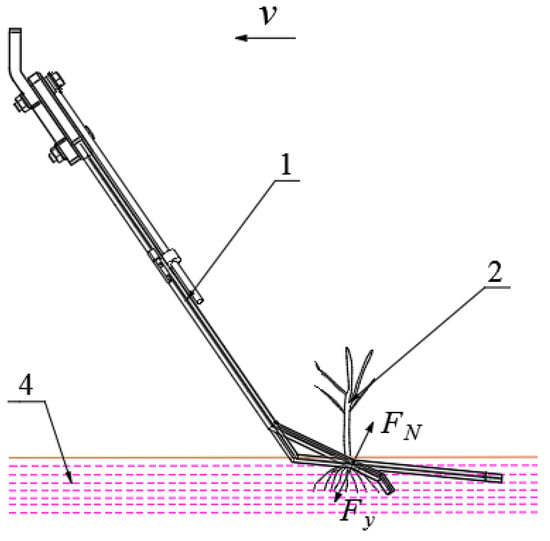
Figure 4.
Mechanical analysis of the weeding device to soil in vertical direction: (1) intra-row weeding device; (2) weed; (4) paddy soil; Fy is the pressure of the weeding device to soil, N; FN is the support force of soil to the weeding device, N.
2.2. Experimental Methods for Elastic Force of Elastic Rods
A measurement experiment was conducted using a high-precision digital dynamometer with a range of 50 N and an accuracy of 0.01 N to determine the variation rule of the elastic force at the end of the elastic rods in the horizontal and vertical directions. When the deformation was the same, the elastic force of the inner elastic rod was always greater than that of the outer elastic rod. Therefore, this experiment only measured the elastic force of the inner elastic rod at the end. The diameters of weeds and rice were different. When the elastic rod made contact with weeds and rice, the deformation of the elastic rod at the end was also different in the horizontal direction. Therefore, the elastic force was measured with the change of displacement in the horizontal direction. When the soil moisture content and weeding depth were different, the deformation of the elastic rod at the end was also different in the vertical direction. Therefore, the elastic force was measured with the change of displacement in the vertical direction. The elastic regulating mechanism can limit the displacement of the elastic rod at the end, thereby changing the elastic force. Therefore, when the regulating mechanism was in different positions, the elastic force was measured with the change of displacement in the horizontal and vertical directions.
In this experiment, the weeding device was placed on a flat surface and one end was fixed. The initial position of the elastic rods and the scale line along the direction of deformation at the end were marked to determine the distance of deformation. The end of the elastic rod was pulled uniformly in the horizontal and vertical directions using a dynamometer to cause a certain displacement, as shown in Figure 5. The numerical values displayed on the dynamometer were recorded at different displacements. The experiment also included separately changing the measuring position of the elastic rod at the end and the position of the regulating mechanism. Table 2 showed the displacement, the measuring position of elastic rod at the end, and the position of the regulating mechanism. Each experiment was repeated three times, and an average value was taken.
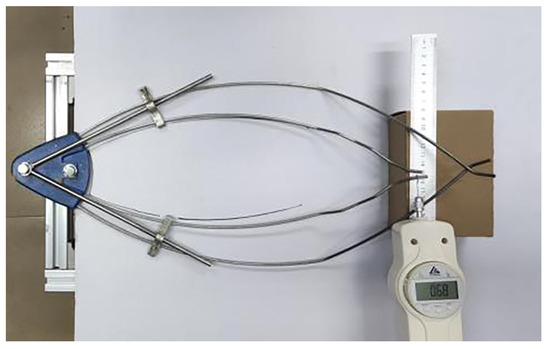
Figure 5.
Experiment for elastic force of the elastic rod.

Table 2.
Parameters of experiment for the elastic force.
2.3. Discrete Element Simulation Experiment
2.3.1. Model of Simulation Experiment
A discrete element simulation experiment was conducted using EDEM2018 to explore the interaction between the intra-row weeding device and soil and determine the optimal weeding parameters. The discrete element parameters of soil model were obtained via calibration experiment, and the specific calibration methods can be found in the relevant literature [28]. The parameters of the soil model and the material of the weeding device are shown in Table 3.

Table 3.
Parameters of soil model and material of the weeding device.
The parameters of the soil particle model and material were set in EDEM 2018 software, as shown in Table 3. The moisture content of paddy soil was relatively high, and the soil particles could bond due to electrostatic forces and moisture content. The Hertz–Mindlin with JKR contact model was mainly suitable for materials with high moisture content such as crops and soil. Therefore, the contact model between particles was set as Hertz–Mindlin with JKR, and the contact model between particles and geometry was set as Hertz–Mindlin (no slip). A simulation test soil tank was established of dimensions 1500 mm × 600 mm × 120 mm, then the soil particle model was established and generated in the soil tank, the radius variation range of particles was 0.8 to 1.2; the weeding device model was imported and the parameters of the material were set. The simulation time step was set to 1 × 10−6 s and the total simulation time was set to 4 s. The data storage interval was 0.05 s, and the grid size was 3 Rmin. The model of simulation experiment is shown in Figure 6.

Figure 6.
Simulation experiment model of intra-row weeding device.
2.3.2. Methods of Simulation Experiment
The better the soil disturbance caused by the weeding device during the weeding process, the more favorable it was for the growth of rice [26]. And the smaller the force of the soil on the weeding device, the better the weeding effect. Therefore, the weeding effect of the weeding device can be reflected in the amount of soil disturbance, and the force of the weeding device in the horizontal and vertical directions. In addition, the weeding depth and weeding speed of the intra-row weeding device had a significant impact on the weeding effect. Therefore, the quadratic orthogonal rotation combination simulation experiment that chose the weeding depth (X1) and weeding speed (X2) as experimental factors, the amount of the soil disturbance, and the force of the inner and outer elastic rod in the horizontal and vertical directions as experimental indicators was conducted. Table 4 showed the coding table of factor levels.

Table 4.
Coding table of factors and levels.
The soil particles were displayed in different colours when the intra-row weeding device drove them to move at different speeds in the simulation experiment. Therefore, the amount of soil disturbance can be expressed by using Photoshop 2020 image processing software to calculate the pixel area of disturbed particles in the cross-section—that is, the pixel area of red and green soil particles. The larger the pixel area, the greater the disturbance to the soil. The pixel areas of disturbed soil particles were calculated at different time points and the average value was taken as the amount of soil disturbance. The weeding device was influenced by soil resistance in the horizontal direction and the soil adhesion force in the vertical direction. The greater the forces in the horizontal and vertical directions, the lower the working efficiency. The forces can be exported in the post-processor of EDEM 2018 software.
2.4. Field Experiment
2.4.1. Experimental Materials
The field experiment was conducted at the Zengcheng Teaching and Research Base of South China Agricultural University in April 2021. Rice of the Xiangyaxiangzhan variety was transplanted with a row spacing of 250 mm and a plant spacing of 200 mm. The weeding time was 15 days after transplanting. The intra-row weeding device was installed on the mechanical weeder for organic rice that was composed of the walking platform and inter-row weeding device [29], as shown in Figure 7. The walking platform included the walking system, floating mechanism, steering mechanism, and control system, and it adopted front-wheel steering and four-wheel drive to walk across two rows of rice, and forward, backward, and steering movement was operated via remote control. The inter-row weeding device capable of efficiently removing weeds between rows and avoid damaging rice roots was installed in the middle of the walking platform through a parallel four-bar mechanism, which was controlled to achieve horizontal lifting via remote control and had left and right profiling functions. The intra-row weeding devices designed in this paper were installed adjacently to the inter-row weeding devices.
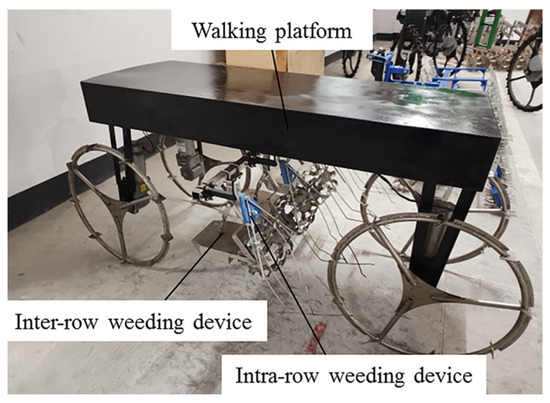
Figure 7.
Mechanical weeder for organic rice.
2.4.2. Experimental Methods
The field experiment was conducted to determine the effect of the intra-row weeding device. The weeding method was as follows: A 5 m long area as a buffer area for acceleration and deceleration of the weeding device was reserved before and after the experimental area to ensure that the weeding device could weed in a stable state. A 4 rows × 10 m was selected as a group of experimental areas, in which the weeding and damaging seedling rates of the intra-row weeding device were calculated. 50 mm on the left and right sides of the rice row were considered as intra-row weeding areas, while the rest were the inter-row weeding areas. If weeds were completely pressed into the mud, broken or uprooted, and lost their activity, they would be considered removed. Similarly, rice that was completely pressed into the mud, broken or uprooted, and lost its activity was considered to be damaging seedlings. The weeding depth and speed of the weeding device were the optimal parameters determined in the simulation experiment. Five experimental treatments, in which the regulating mechanism was fixed in five positions (420, 370, 320, 270, 220 mm), were set up in this field experiment to determine the weeding effect of the weeding device under different elastic forces at the end of the elastic rods. Each experimental treatment included three groups of experimental areas. The weeding time was 15 days after transplanting. The weeding and damaging seedling rates of each experimental area and experimental treatment were calculated.
2.4.3. Experimental Indexes and Analysis Methods
- (1)
- Weeding rate
The weeding rate was one of the important indicators to test the weeding effect of the weeding device. In this experiment, the number of weeds before weeding and remaining weeds after weeding were separately counted in each experimental area, then the weeding rate was calculated using the following formula:
where W is the weeding rate of the intra-row weeding device (%); N is the number of weeds before weeding; M is the number of remaining weeds after weeding.
- (2)
- Damaging seedling rate
The damaging seedling rate was one of the important indicators to test the weeding effect of the intra-row weeding device. The amounts of rice before and after weeding were separately counted in each experimental area, then the damaging seedling rate was calculated using the following formula:
where D is the damaging seedling rate of the intra-row weeding device (%); T is the rice count before weeding; I is the rice count after weeding.
- (3)
- Data analysis
The variance of each experimental index was analysed using Statistics 23 data analysis software. The difference between different weeding treatments on each index was analysed at the level of 0.05 significance by using the least significant difference (LSD).
3. Results and Analysis
3.1. Results and Analysis of Elastic Force Experiment
3.1.1. Elastic Force of Elastic Rods in the Horizontal Direction
Figure 8 showed the elastic forces of the elastic rod at the end in the horizontal direction under different positions of the measurement and regulating mechanisms and different displacements. When the positions of measurement and regulating mechanisms were confirmed, the elastic force gradually increased as the displacement of the elastic rod at the end increased; when the displacement and measuring position were confirmed, the position of the regulating mechanism was closer to the end of the elastic rod, and the elastic force was larger. When the position of regulating mechanism and displacement were confirmed, the elastic force gradually increased as the distance between the measuring position and the end of the elastic rod increased.
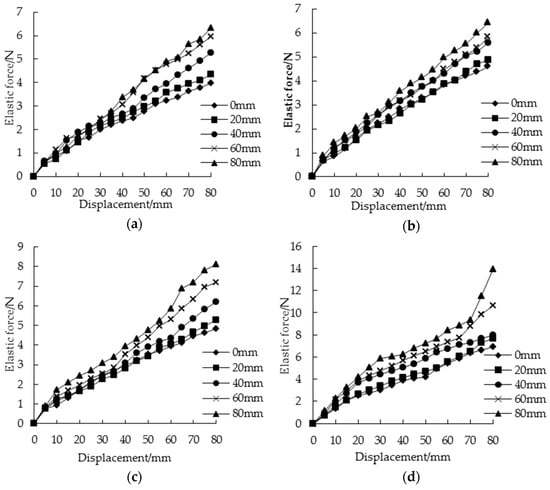
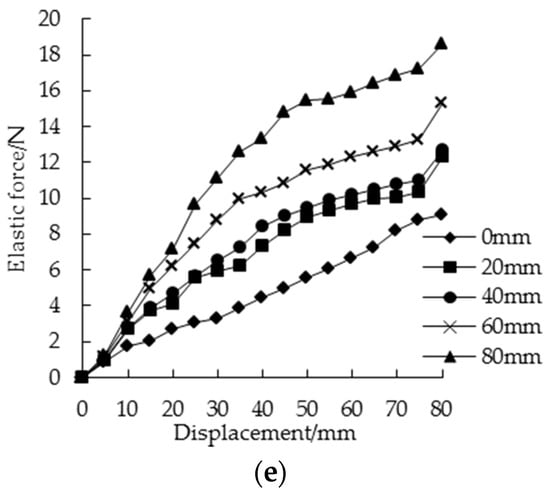
Figure 8.
Elastic forces of the elastic rods at the end in the horizontal direction: (a) the position of the regulating mechanism was 420 mm; (b) the position of the regulating mechanism was 370 mm; (c) the position of the regulating mechanism was 320 mm; (d) the position of the regulating mechanism was 270 mm; (e) the position of the regulating mechanism was 220 mm.
There was a certain correlation among the measuring position, displacement, the position of the regulating mechanism, and the elastic force. According to the experimental results, the fitting equation between elastic force and the measuring position or displacement or the position of the regulating mechanism can be obtained. For example, when the position of measurement and regulating mechanism were 20 and 220 mm, respectively, the fitting equation between the elastic forces and displacement can be obtained:
where F is the elastic force of the elastic rod at the end in the horizontal direction, N; S1 is the displacement of the elastic rod at the end in the horizontal direction, mm.
When the measuring position and displacement were 20 and 10 mm, respectively, the fitting equation between the elastic forces and the position or the regulating mechanism can be obtained:
where F is the elastic force of the elastic rod at the end in the horizontal direction, N; S2 is the position of the regulating mechanism in the horizontal direction, mm.
In conclusion, the elastic force of the elastic rods at the end in the horizontal direction was different when the different displacement was generated under different positions, and it can be adjusted by changing the position of the regulating mechanism. Therefore, according to the stem diameters and mechanical properties of weeds and rice, the elastic force of the elastic rods can be selected when weeding.
3.1.2. Elastic Force of Elastic Rods in the Vertical Direction
Figure 9 showed the elastic forces of the elastic rods at the end in the vertical direction under different positions of the regulating mechanism and different displacements. When the position of the regulating mechanism was confirmed, the elastic force gradually increased with the displacement increased; when the displacement was confirmed, the position of the regulating mechanism was closer to the end of the elastic rod, and the elastic force was greater. When the displacement exceeded 100 mm, the elastic rods would experience irreversible deformation.

Figure 9.
Elastic forces of the elastic rod at the end in the vertical direction.
According to the experimental results, the fitting equation between elastic force and the displacement or the position of the regulating mechanism can be obtained. For example, when the position of the regulating mechanism was 220 mm, the fitting equation between the elastic forces and displacement can be obtained:
where Fv is the elastic force of the elastic rod at the end in the vertical direction, N; S3 is the displacement of the elastic rod at the end in the vertical direction, mm.
When the displacement was 10 mm, the fitting equation between the elastic forces and the position of the regulating mechanism can be obtained:
where Fv is the elastic force of the elastic rod at the end in the vertical direction, N; S4 is the displacement of the elastic rod at the end in the vertical direction, mm.
In conclusion, the elastic force of the elastic rods in the vertical direction was different when the different displacement was generated, and it can be adjusted by changing the position of the regulating mechanism. Therefore, the elastic force of the elastic rod in the vertical direction can be selected according to the weeding depth and soil moisture content in the paddy field.
3.2. Results and Analysis of Discrete Element Simulation Experiment
3.2.1. Analysis of Simulation Effects
Figure 10a,b showed the simulation effects of the weeding device under the same weeding depths and different weeding speeds. The soil particles moved faster as the speed of the weeding device increased, and it caused significant disturbance to the soil. Figure 10c,d showed the simulation effects of the weeding device under the same weeding speeds and different weeding depths. The weeding width increased as the weeding depth increased, and the amount of soil disturbance also increased. Therefore, the faster weeding speed and deeper weeding depth should be selected to ensure a certain amount of soil disturbance and weeding range.


Figure 10.
Simulation effect of the intra-row weeding device: (a) the weeding speed was slower; (b) the weeding speed was faster; (c) the weeding depth was shallower; (d) the weeding depth was deeper.
3.2.2. Establishment and Significance Analysis of Regression Equation
The experimental scheme and results are shown in Table 5. The results of variance analysis, significance, and mismatch tests for the experimental indexes are shown in Table 6. The experimental results showed that the weeding depth and weeding speed had significant effects on each experimental index (p < 0.01) and the order of the significant influence was weeding depth > weeding speed. The regression analyses of the experimental results for the indexes were carried out using Design-Expert.V8.0.6.1 test analysis software, and the optimised regression equations between the experimental factors and indexes were obtained as follows:

Table 5.
Experimental scheme and results: x1 is the coded value corresponding to the weeding depth X1; x2 is the coded value corresponding to the weeding speed X2; Y1 is the amount of soil disturbance; Y2 is the forward resistance of the inner elastic rod; Y3 is the force in the vertical direction of the inner elastic rod; Y4 is the forward resistance of the outer elastic rod; Y5 is the force in the vertical direction of the outer elastic rod.

Table 6.
Results of ANOVA, significance, and mismatch tests of each experimental index: ** indicates extremely significant level (p < 0.01); * indicates significant level (p < 0.05).
The variance and significance analysis of the regression models for experimental indexes were carried out at the F = 0.01 significance level, the results of which are shown in Table 6. The F values of the regression equations were greater than F0.01(5,10) = 5.64—that is, p < 0.01. It showed that the regression equations were extremely significant. The multiple correlation indexes of the regression models showed that the models had a good fitting degree—that is, the correlation between the experimental value and predicted value was very good and the regression models can be used to explain the change of the indexes with the factors. The results of the mismatch test for each regression model are shown in Table 6. The F values of the mismatch test of the regression models were less than F0.01(3,7) = 4.35, that was, p > 0.05, indicating that the mismatch of each regression model was not significant—that is, the models were correct, and the prediction of each index can be carried out by the corresponding regression model.
3.2.3. Analysis of Response Surface and Optimization Results
The response surface analysis on the experimental results was conducted using Design-Expert.V8.0.6.1 test analysis software. The response surface diagrams of the relationship between the experimental factors and indexes are shown in Figure 11. When the weeding depth was constant, each experimental index increased gradually with the increase in the weeding speed. When the weeding speed was constant, each experimental index also increased with the increase in the weeding depth.

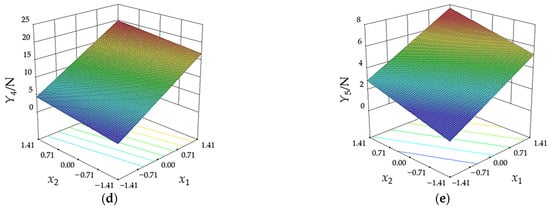
Figure 11.
Response surface diagrams: (a) amount of soil disturbance; (b) forward resistance of the inner elastic rod; (c) force in the vertical direction of the inner elastic rod; (d) forward resistance of the outer elasticthed; (e) force in the vertical direction of the outer elastic rod.
3.2.4. Comprehensive Optimization
The experimental results of the indexes optimised using Design-Expert.V8.0.6.1 data analysis software optimized program was set as follows: the target parameters of the force of the inner and outer elastic rod in the horizontal and vertical directions were taken as the minimum, and the target parameter of the amount of soil disturbance was taken as the maximum. The optimal parameters combination of the experimental factors can be obtained: the weeding depth was 15.37 mm, and the weeding speed was 0.93 m/s. At this time, the values of the experimental indexes were as follows: the amount of soil disturbance was 3.85 × 103 mm3, and the forces of the inner and outer elastic rod in the horizontal and vertical directions were 3.52 N, 2.89 N, 4.46 N, and 2.2 N, respectively. To ensure the availability of the working parameters, the optimal parameters were rounded, so that the weeding depth was 15 mm, and the weeding speed was 0.9 m/s; these were used as the experimental conditions for the field experiment, and the effect of the field experiment was observed.
3.3. Results and Analysis of Field Experiment
The weeds in the paddy fields in this experiment mainly included barnyard grass and Leptochloa chinensis. The average heights of weeds and rice were 150 mm and 392 mm, respectively. The field experiment of the mechanical weeder for organic rice is shown in Figure 12 and the experimental results of the intra-row weeding device at different positions of the regulating mechanism are shown in Table 7. The experimental results showed that the positions of the regulating mechanism had significant effects on the rates of weeding and damaging seedlings under the same soil conditions and growth period of rice (p < 0.05). The distance between the regulating mechanism and the end of the elastic rod was closer—that is, the elastic force of the elastic rod at the end was greater, and the weeding rate of the intra-row weeding device was higher, but the rate of damaging seedlings was also higher. When the position of the regulating mechanism was 420 mm, the rates of weeding and damaging seedlings were lowest, with an average value of 53.99% and 0.45%, respectively. When the position of the regulating mechanism was 270 mm, the weeding rate was highest, with an average value of 80.65% and the rate of damaging seedlings was higher, with an average value of 3.36%. When the position of the regulating mechanism was 220 mm, the rate of damaging seedlings was highest, with an average value of 5.36%. In conclusion, the optimal position of the regulating mechanism was 270 mm under the conditions of this experiment.
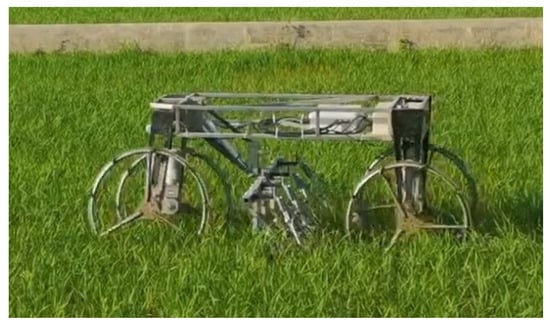
Figure 12.
Field operation of mechanical weeder for organic rice.

Table 7.
Weeding and damaging seedling rates at different positions of regulating mechanism.
4. Discussion
In this paper, an intra-row weeding device with double-layer elastic rods was designed according to the differences in mechanical properties between rice and weeds. The elastic force of the elastic rods can be adjusted to be larger than the bending resistance force of weeds, but smaller than that of rice, so that the weeding device can press weeds into soil and avoid damaging plants of rice. This weeding method can improve the intra-row weeding effects. The experiment results of the elastic force experiment for the elastic rod indicated that the elastic force in the horizontal and vertical directions can be adjusted with some regularity by changing the position of the regulating mechanism, so as to adapt to different weeding conditions.
In field experiment, the weeding time was 15 days after transplanting. At this time, the plant heights of rice and weeds were approximately 400 mm and 151 mm, respectively; the stem diameters of rice and weeds were approximately 40 mm and 2.54 mm, respectively. The bending resistance forces of weeds and rice were measured with average values of 1.65 N and 5.45 N, respectively. Therefore, the elastic force of the elastic rods at the end should be larger than 1.65 N, but less than 5.45 N when weeding. According to the experimental results of the elastic force experiment for the elastic rod (Figure 8), when the position of the regulating mechanism was 270 mm or 220 mm, the elastic force was larger than the bending resistance force of weeds, which met the weeding requirements of this field experiment. But when the position of the regulating mechanism was 220 mm, the elastic force was larger than the bending resistance force of some rice. The rate of damaging rice would increase. The soil moisture content in this field experiment was 35%, which was higher when weeding. Therefore, the elastic force in the vertical direction should be increased to improve the weeding effect. Therefore, the optimal position of the regulating mechanism was 270 mm.
The results of the field experiment indicated that when the position of the regulating mechanism was 270 mm, the weeding rate of the intra-row weeding device was high and could reach 80.65% under the weeding speed and depth that were obtained during the simulation experiment. Under the soil conditions and rice growth period of this experiment, compared with the position of the regulating mechanism at 420 mm, the weeding rate of the weeding device can increase by at least 11.18% by adjusting the regulating mechanism to 270 mm. The weeding device can completely press most of the weeds into the soil and some weaker weeds were pulled out. The motion trajectory of the elastic rods had the same effect with the results of the simulation experiment. The weeding width of the outer elastic rod was wider than that of the inner. The weeding device can also cause certain disturbances to the soil, which can increase soil permeability. When rice was weaker or the elastic force of the elastic rods was larger, the elastic rods would press rice into the soil, as shown in Figure 13a. Therefore, when the position of the regulating mechanism was 220 mm, the rate of damaging rice was higher. When rice was stronger and the weeding device passed through the rice, the elastic rods could be strutted by rice and could not damage rice, as shown in Figure 13b. In conclusion, the experimental results were consistent with the theoretical analysis results of the weeding process.

Figure 13.
Field operation of mechanical weeder in paddy field: (a) weaker rice; (b) stronger rice.
5. Conclusions
In this paper, an intra-row weeding device with double-layer elastic rods was designed according to the differences in mechanical properties between rice and weeds, which can press weeds into the soil and avoid damaging rice. The elastic force of the elastic rods at the end can be adjusted by changing the position of the regulating mechanism to adapt to different weeding conditions. In this paper, the mechanical properties of rice and weeds and the acting forces between the elastic rods and rice, weed, and soil were analysed. It can be concluded that the elastic force of the elastic rods at the end in the horizontal direction should be weaker than the bending resistance force of rice and greater than that of weeds when weeding, so that it can press weeds into the soil. The elastic force experiment of the elastic rods at the end was conducted to determine the variation rule in the horizontal and vertical directions. The experiment results indicated that the elastic force in the horizontal and vertical directions can be adjusted with some regularity by changing the position of the regulating mechanism, so as to adapt to different weeding conditions. The discrete element simulation experiment was conducted to explore the interaction between the intra-row weeding device and soil optimized regression equations between the experimental factors and indexes were obtained. And the variance, significance, and response surface analyses were conducted. The optimal combination of parameters for each of the factors was obtained: the weeding depth was 15 mm, and the weeding speed was 0.9 m/s. The field experiment was conducted to determine the effect of the intra-row weeding device. The experiment results showed that the optimal position of the regulating mechanism was 270 mm, with a weeding rate of 80.65% and a rate of damaging seedlings of 3.36%. The weeding rate can increase by at least 11.18% when adjusting the regulating mechanism to a suitable position under the same weeding conditions. In conclusion, the intra-row weeding device designed in this paper can meet the design and weeding requirements for organic rice.
Author Contributions
Conceptualization, J.J., L.H. and Y.Z.; methodology, J.J. and L.H.; software, G.C.; validation, J.J. and C.C.; formal analysis, J.J. and G.C.; investigation, J.J.; resources, C.C.; data curation, J.J.; writing—original draft preparation, J.J.; writing—review and editing, L.H. and Y.Z.; visualization, J.J. and G.C.; supervision, L.H. and Y.Z.; project administration, L.H. and Y.Z.; funding acquisition, L.H. and Y.Z. All authors have read and agreed to the published version of the manuscript.
Funding
This research was funded by Agricultural research and technology promotion demonstration projects in Guangdong Province (Yuecainong[2022] No. 152), Research project of Huangpu Innovation Research Institute of South China Agricultural University (2023GG001) and Key Realm R&D Program of Guangdong Province (No. 2019B020221002).
Institutional Review Board Statement
Not applicable.
Data Availability Statement
Data are contained within the article.
Acknowledgments
We would like to thank the anonymous reviewers for their critical comments and suggestions for improving the manuscript.
Conflicts of Interest
The authors declare no conflicts of interest.
References
- Tian, Z.H.; Lu, J.Y.; Yuan, G.H.; Shen, G.H. Effect and eco-economic thresholds of Leptochloa chinensis and Cyperus difformis on the yield of direct-seeding rice. Chin. J. Eco-Agric. 2020, 28, 328–336. [Google Scholar] [CrossRef]
- Zhu, S.; Deng, J.Z.; Zhang, Y.L.; Yang, C.; Yan, Z.W.; Xie, Y.Q. Study on distribution map of weeds in rice field based on UAV remote sensing. J. South China Agric. Univ. 2020, 41, 67–74. [Google Scholar]
- Xu, C.C.; Ji, L.; Li, F.B.; Feng, J.F.; Fang, F.P. Situation and strategies of rice industry development in China. J. Huazhong Agric. Univ. 2022, 41, 21–27. [Google Scholar] [CrossRef]
- Hosoya, K.; Sugiyama, S. Weed communities and their negative impact on rice yield in no-input paddy fields in the northern part of Japan. Biol. Agric. Hortic. 2017, 33, 215–224. [Google Scholar] [CrossRef]
- Liu, X.L.; Sun, T.; Fu, S.J.; Zhong, G.H. Herbicide application and weeds resistance in rice field in China. J. Northwest A. F. Univ. 2015, 43, 115–126. [Google Scholar] [CrossRef]
- Qi, L.; Liu, C.; Jiang, Y. Present status and intelligent development prospects of mechanical weeding technology and equipment for rice. J. South China Agric. Univ. 2020, 41, 29–36. [Google Scholar]
- Andert, S.; Gerowitt, B. Mechanische und chemische Unkrautbekämpfung im Mischanbau von Mais und Bohne. Jul.-Kühn-Arch. 2018, 458, 223–230. [Google Scholar] [CrossRef]
- Yao, W.Q.; Wu, D.; Xiao, M.H.; Qian, Y.; Song, J.F.; Ge, Y.Y. Design and analysis of multi-functional variable speed weeding machine. Int. Agric. Eng. J. 2018, 37, 176–184. [Google Scholar]
- Azadbakht, A. The effect of chemical and non-chemical control methods on weeds in potato (Solanum tuberosum L.) cultivation in Ardabil province, Iran. Appl. Ecol. Environ. Res. 2017, 15, 1359–1372. [Google Scholar] [CrossRef]
- Dilipkumar, M.; Chuah, T.S.; Goh, S.S.; Sahid, I. Weed management issues, challenges, and opportunities in Malaysia. Crop. Prot. 2020, 134, 104347. [Google Scholar] [CrossRef]
- Nosratti, I.; Sabeti, P.; Chaghamirzaee, G.; Heidari, H. Weed problems, challenges, and opportunities in Iran. Crop. Prot. 2020, 134, 104371. [Google Scholar] [CrossRef]
- Huang, Z.C.; Zhou, K.; Kuang, W.; Wang, D.W.; Zhang, S.H.; Li, Z.H.; Li, Y.Y.; Huang, W. Effects of rice-tortoise symbiosis mode on weeds and rice pests. Hunan Agric. Sci. 2022, 8, 17–20. [Google Scholar] [CrossRef]
- Wang, J.F.; Weng, W.X.; Ju, J.Y.; Chen, X.S.; Wang, J.W.; Wang, H.L. Design and test of weeder between rows in rice field based on remote control steering. Trans. Chin. Soc. Agric. Mach. 2021, 52, 97–105. [Google Scholar]
- Luo, X.W.; Liao, J.; Hu, L.; Zang, Y.; Zhou, Z.Y. Improving agricultural mechanization level to promote agricultural sustainable development. Trans. Chin. Soc. Agric. Eng. 2016, 32, 1–11. [Google Scholar] [CrossRef]
- Wang, J.W.; Li, C.; Li, X.; Li, X.; Wang, J.F. Design and experiment of 3SCJ-1 type weeding machine for paddy field applied to film mulching and transplanting. Trans. Chin. Soc. Agric. Mach. 2018, 49, 102–109. [Google Scholar]
- Maimunah, M.A.; Kautsar, V.; Bimantara, P.O.; Kimani, A.M.; Torita, R.; Tawaraya, K.; Murayama, H.; Utami, S.N.H.; Purwanto, B.H.; Cheng, W.G. Weeding Frequencies Decreased Rice–Weed Competition and Increased Rice N Uptake in Organic Paddy Field. Agronomy 2021, 11, 1904. [Google Scholar] [CrossRef]
- Marcinkevičienė, A.; Velička, R.; Butkevičienė, L.M.; Keidan, M.; Pupaliene, R.; Kriauciuniene, Z.; Kosteckas, R.; Cekanauskas, S.; Raudonius, S. The impact of non-chemical weed control methods on the disease occurrence in the organically grown winter oilseed rape crop. Zemdirb. Agric. 2018, 105, 331–338. [Google Scholar] [CrossRef]
- Gongotchame, S.; Dieng, I.; Ahouanton, K.; Johnson, J.M.; Alognon, A.D.; Tanaka, A.; Atta, S.; Saito, K. Participatory evaluation of mechanical weeders in lowland rice production systems in Benin. Crop. Prot. 2014, 61, 32–37. [Google Scholar] [CrossRef]
- Shoji, K.; Itoh, K.; Kawahara, F.; Yoshida, Y.; Yamamoto, Y.; Sudo, K.I. Micro-elevations in paddy fields affect the efficacy of mechanical weeding: Evaluation of weeding machines to control Monochoria vaginalis in herbicide-free farming. Weed Biol. Manag. 2013, 13, 45–52. [Google Scholar] [CrossRef]
- Gobor, Z.; Lammers, P.S.; Martinov, M. Development of a mechatronic intra-row weeding system with rotational hoeing tools: Theoretical approach and simulation. Comput. Electron. Agric. 2013, 98, 166–174. [Google Scholar] [CrossRef]
- Khaliq, A.; Ahmad, H.B.; Nadeem, M.A.; Mehmood, A.; Ahmad, N.; Yasin, M.; Sher, R. Valuation of Weed Control Methods by using Inter Row Rotary Weeder in Sugarcane Crop. Indian J. Agric. Res. 2020, 54, 666–670. [Google Scholar] [CrossRef]
- Merfield, C.N. Robotic weeding’s false dawn? Ten requirements for fully autonomous mechanical weed management. Weed Res. 2016, 56, 340–344. [Google Scholar] [CrossRef]
- Pannacci, E.; Tei, F.; Guiducci, M. Mechanical weed control in organic winter wheat. Ital. J. Agron. 2017, 12, 4. [Google Scholar] [CrossRef]
- Wang, J.W.; Yan, D.W.; Wang, Q.; Tang, H.; Wang, J.F.; Zhou, W.Q. Design and experiment of jet-type paddy field weeding device between plants. Trans. Chin. Soc. Agric. Mach. 2021, 52, 78–85+94. [Google Scholar]
- Liu, C.; Qi, L.; Ma, X.; Jiang, Y. Design and test of high efficiency mechanical weeding device for inter-row and intra-row synchronization in paddy field. J. Agric. Mech. Res. 2021, 43, 78–82. [Google Scholar] [CrossRef]
- Jiang, Y.; Qi, L.; Gong, H.; Liu, C.; Tao, M.; Hu, X.L.; Chen, Q.L. Design and experiment of pneumatic paddy intra-row weeding device. J. South China Agric. Univ. 2020, 10, 78–82. [Google Scholar]
- Liu, Y.J. Study on Mechanical Properties of Rice Seedling and Barnyard Grassed in the Field. Master’s Thesis, Northeast Agricultural University, Harbin, China, 2014. [Google Scholar]
- Zhou, H. Study on Key Technologies of Laser-Controlled Paddy Field Levelling-Beater. Ph.D. Thesis, South China Agricultural University, Guangzhou, China, 2019. [Google Scholar]
- Jiao, J.K.; Wang, Z.M.; Luo, H.W.; Chen, G.L.; Liu, H.L.; Guan, J.J.; Hu, L.; Zang, Y. Development of a mechanical weeder and experiment on the growth, yield and quality of rice. Int. J. Agric. Biol. Eng. 2022, 15, 92–99. [Google Scholar] [CrossRef]
Disclaimer/Publisher’s Note: The statements, opinions and data contained in all publications are solely those of the individual author(s) and contributor(s) and not of MDPI and/or the editor(s). MDPI and/or the editor(s) disclaim responsibility for any injury to people or property resulting from any ideas, methods, instructions or products referred to in the content. |
© 2024 by the authors. Licensee MDPI, Basel, Switzerland. This article is an open access article distributed under the terms and conditions of the Creative Commons Attribution (CC BY) license (https://creativecommons.org/licenses/by/4.0/).